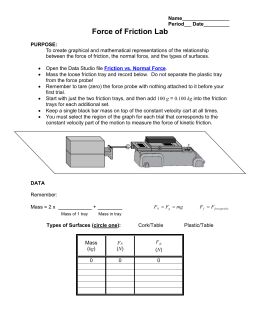

Researchers are finding that the atomic nature of friction seems to have several fundamental characteristics.


Great strides have been made in the atomic-scale explanation of friction during the past several decades. The simpler aspects of friction dealt with so far are its macroscopic (large-scale) characteristics. These forces act in opposite directions, so when they have equal magnitude, the acceleration is zero. At small but nonzero speeds, friction is nearly independent of speed.įigure 6.11 (a) The force of friction \overset\,\theta (see the free-body diagram in (Figure)). Once an object is moving, there are fewer points of contact (fewer molecules adhering), so less force is required to keep the object moving. Adhesion varies with substances in contact and is a complicated aspect of surface physics. For example, rubber-soled shoes slip less than those with leather soles. Part of the friction is due to adhesive forces between the surface molecules of the two objects, which explains the dependence of friction on the nature of the substances. The harder the surfaces are pushed together (such as if another box is placed on the crate), the more force is needed to move them. A considerable force can be resisted by friction with no apparent motion. Thus, when you push to get an object moving (in this case, a crate), you must raise the object until it can skip along with just the tips of the surface hitting, breaking off the points, or both. Close-up inspection of these surfaces shows them to be rough. (Figure) is a crude pictorial representation of how friction occurs at the interface between two objects. Furthermore, if you oiled the concrete you would find it easier to get the crate started and keep it going (as you might expect). If you add mass to the crate, say by placing a box on top of it, you need to push even harder to get it started and also to keep it moving. Once in motion, it is easier to keep it in motion than it was to get it started, indicating that the kinetic frictional force is less than the static frictional force. Now static friction gives way to kinetic friction. If you finally push hard enough, the crate seems to slip suddenly and starts to move. This means that the static friction responds to what you do-it increases to be equal to and in the opposite direction of your push. Imagine, for example, trying to slide a heavy crate across a concrete floor-you might push very hard on the crate and not move it at all. If two systems are in contact and moving relative to one another, then the friction between them is called kinetic friction. If two systems are in contact and stationary relative to one another, then the friction between them is called static friction.


 0 kommentar(er)
0 kommentar(er)
